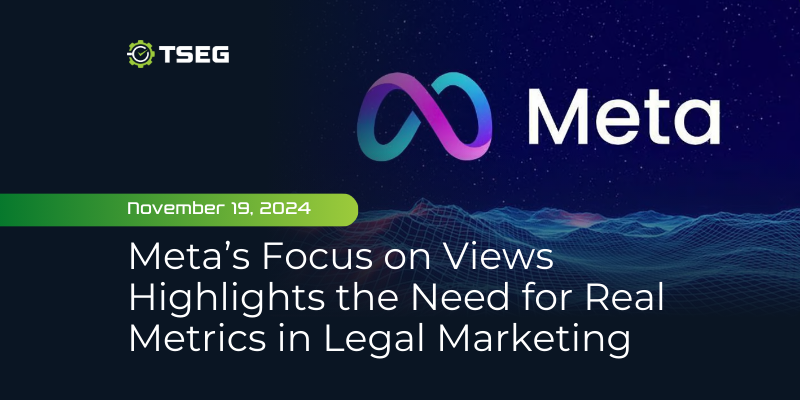Meta’s Focus on Views Highlights the Need for Real Metrics in Legal Marketing
Posted on Tuesday, November 19th, 2024 at 3:58 pm
Meta’s New Standard for Measuring Performance
Meta has introduced a significant update to its performance metrics, standardizing “views” as the central measure of content performance across its platforms: Facebook, Instagram, and Threads. This change aims to provide advertisers with a unified method for assessing how many people see their content, making reporting simpler and more consistent.
The update ensures that metrics align across these platforms, reflecting the number of times a piece of content is displayed to users, regardless of whether they actively engage with it. Meta emphasizes that this shift will create clarity for advertisers by eliminating discrepancies in how performance is measured on each platform. For example, advertisers running campaigns across multiple Meta platforms can now compare results more easily, using a single, standardized metric to evaluate reach and visibility.
Additionally, Meta hopes this adjustment will enhance transparency in its reporting tools, allowing advertisers to focus on how content is delivered to audiences. By using “views” as a key metric, the company aims to showcase the visibility of posts, ads, and videos, helping businesses better understand their audience’s exposure to their messages. This update is part of Meta’s broader strategy to streamline its tools and improve usability for advertisers across its ecosystem.
Why “Views” Fall Short for Legal Marketing
Meta’s decision to focus on “views” as a standardized metric might simplify reporting, but for law firms, it highlights the dangers of relying on “fluff” metrics. “Views” are a classic example of a metric that might look good on paper but offers little substance. They count how many times content appears on a screen, yet they fail to provide insight into meaningful engagement or measurable outcomes.
In legal marketing, where every marketing dollar must drive results, metrics like “views” create a false sense of success. They don’t reveal whether someone clicked on an ad, engaged with the content, or contacted the firm. Without tracking these actions, it’s nearly impossible to understand the true impact of a campaign. High view counts may look impressive, but they often fail to translate into signed cases or ROI.
By contrast, actionable metrics—such as clicks, conversions, and cost per case—are what truly matter. These metrics show the direct results of marketing efforts, providing the insight needed to optimize campaigns and allocate resources effectively. They measure the steps potential clients take, from visiting a landing page to reaching out for legal help.
For law firms, focusing on “fluff” metrics is a distraction from what really counts. In a results-driven industry, meaningful metrics provide the clarity and direction needed to generate cases and grow a practice.

TSEG’s Approach: Case Generation Through Real Metrics
At TSEG, we prioritize metrics that truly matter to law firms: clicks and conversions. Our approach is rooted in the understanding that vanity metrics, like views, fail to provide actionable insights. Instead, we focus on performance data that reveals what’s working—and what’s not—so campaigns can be adjusted to maximize results.
Our transparent reporting empowers law firms to make informed decisions based on data that directly impacts their goals. By tracking client engagement and case outcomes, TSEG ensures that every marketing dollar is optimized for tangible success. For instance, instead of celebrating how many people saw an ad, we look at how many took meaningful steps, such as visiting a landing page, calling the firm, or signing a contract.
With over 15 years of experience exclusively serving law firms, TSEG knows that generating cases requires strategies built around metrics that drive real impact. We work as partners, not just vendors, ensuring every campaign aligns with the ultimate goal: delivering more cases to the firm. Partner with us today to make a real difference for your law firm.
